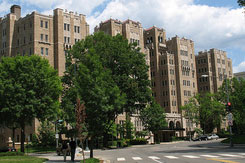Three thoughts from Connecticut Avenue
I occasionally drive along Connecticut Avenue, and did so again this weekend coming into the District. Each trip is a great opportunity to witness some traffic engineering, driver behavior, and land use in action.
What’s the big deal about tall buildings? At the recent hearing on townhouses in Wheaton-Kensington, some residents argued that the three-story townhouses, located up the hill from their homes, would “loom” over their neighborhood and decrease their property values. Opponents of the Whitman-Walker project on 14th Street claim a seven-story building will overshadow their three-story townhouses and destroy their neighborhood.
After hearing so much vitriol against three to seven story buildings, we need to regain a little perspective. There are some gorgeous ten-story buildings flanking Connecticut around Belmont and Kalorama Streets (just south of the bridge to Woodley Park), very close to some two- and three-story homes. If only more of our new residential development could look like that.
Plus, even DC’s “huge” buildings aren’t really objectively tall at all. Boston’s Prudential Center or John Hancock tower may loom over the historic brownstones of the Back Bay and South End, but even that large height disparity creates some quite beautiful views (and a nice, walkable area, despite the Prudential Center’s skybridges).
Height can be beautiful. Left: 2101 Connecticut Avenue. Photo by Mr. T in DC.
Right: Boston’s Prudential tower and the South End. Photo by ckirkman.
Near misses don’t equal danger. A few months ago, DDOT decided to remove a very successful pedestrian signal at Morrison and Connecticut. Originally, this intersection had a stop sign, but it was hard for pedestrians to cross. So neighbors petitioned for a new signal that flashed red (stop) on Morrison, like before, and yellow on Connecticut. But when a pedestrian wanted to cross, they could press a button to make all directions red for a short time. Before long, some other neighbors started saying this was confusing, and petitioned for DDOT to convert the signal to a classic traffic light.
DDOT agreed, saying that they had observed “several near misses” at the intersection. But near misses aren’t the same as hits. 1950s traffic engineering philosophy says we should separate pedestrians and vehicles as much as possible, for safety. That’s why they built skybridges in Rosslyn (and still do in Silver Spring). Separation makes traffic move faster, and makes drivers less alert for danger. Modern roundabouts are safer than large, conventional intersections, even though (actually, specifically because) they force cars and pedestrians moving in different directions to interact closely. It might be more stressful for the driver, but statistics show it’s safer, too.
Motorists really do drive badly. I’ve seen drivers drop styrofoam cups out of their windows, blow through innumerable lights, and aggressively refuse to let others change lanes anywhere near them. And like Jim Graham said, almost all of the transgressors I see are sporting Maryland and Virginia plates.


